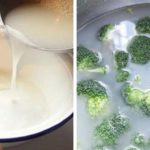Cauliflower is a versatile and nutritious vegetable, beloved by many for its ability to be transformed into a myriad of delicious dishes. From stir-fries to soups, each preparation offers a unique and captivating flavor experience.
One might assume that cauliflower is relatively easy to clean, given its seemingly smooth surface. A common practice is to simply chop it into smaller pieces and rinse with water, or even wash the entire head before cutting. However, it’s important to recognize that cauliflower has numerous nooks and crannies where dirt, insect eggs, and pesticide residues can lurk.
To truly ensure the cleanliness of this vegetable, a renowned chef recommends an additional step beyond a simple water rinse. Read on to discover three effective methods for thoroughly cleaning your cauliflower:
Method 1: Rice Water and Salt Solution
Rice water, a byproduct of washing rice, has mild acidic properties that help remove pesticide residues from vegetables. Its absorptive nature, coupled with the addition of salt, makes it a powerful tool for eliminating dirt, insect eggs, and debris hidden within the florets.
Simply cut the cauliflower into small florets and soak them in a mixture of rice water and a pinch of salt for 10-15 minutes. To ensure complete submersion, place a plate or rack over the cauliflower. Finally, rinse the florets two to three times with clean water, and your cauliflower will be perfectly clean and ready to use.
Method 2: Flour and Salt Solution
Salt, known for its antibacterial properties, and flour, with its high absorbency, make an effective duo for cleaning cauliflower. The salt helps eliminate bacteria, while the flour absorbs any remaining impurities, including pesticide residues.
Cut the cauliflower into small florets and prepare a solution by mixing two to three spoons of flour and two spoons of salt with water in a bowl or bucket. Soak the florets in this solution for 10-15 minutes, then rinse them thoroughly under running water. This method ensures that your cauliflower is thoroughly cleaned and safe to consume.

Method 3: Baking Soda Solution
Baking soda is a powerful cleaning agent, capable of dislodging dirt, insect eggs, and residues from the crevices of the cauliflower. It also helps neutralize any pesticide residues that may be present.
Prepare a solution by mixing two spoons of baking soda with water in a bucket or large container. Soak the chopped cauliflower in this solution for 10-15 minutes, then discard the dirty water and rinse the florets thoroughly under running water. This method ensures that your cauliflower is not only clean but also free from any unwanted chemicals or residues.
We hope these methods empower you to confidently prepare and enjoy this versatile and nutritious vegetable. Happy cooking!
Source: Phụ nữ Việt Nam (Viet Nam Women)







































